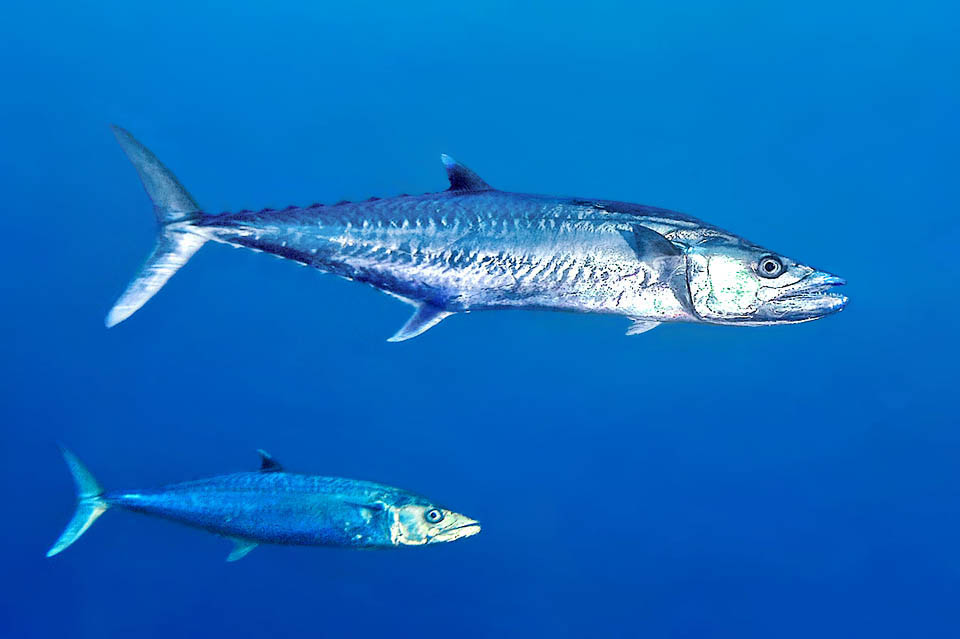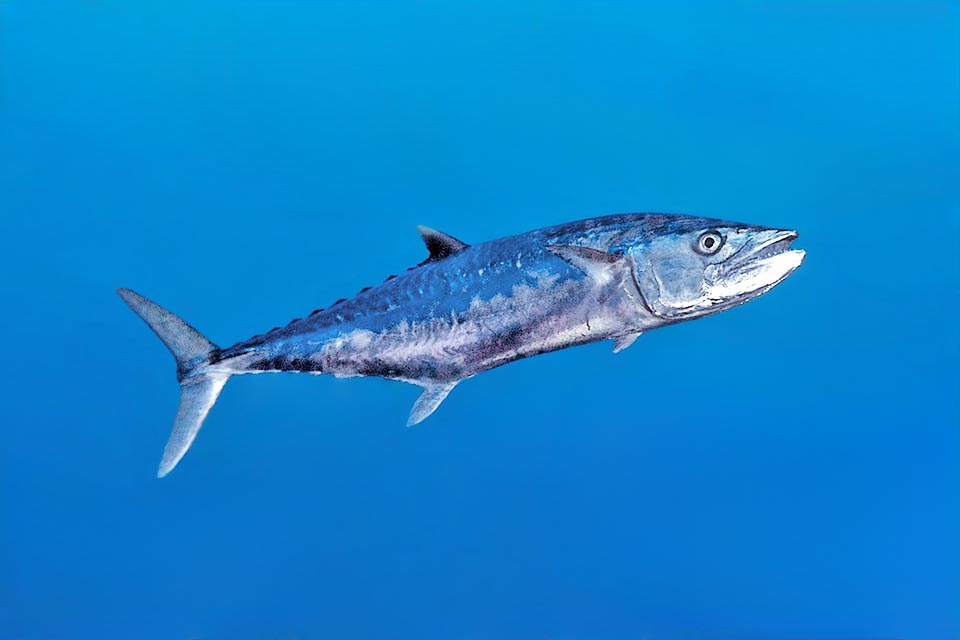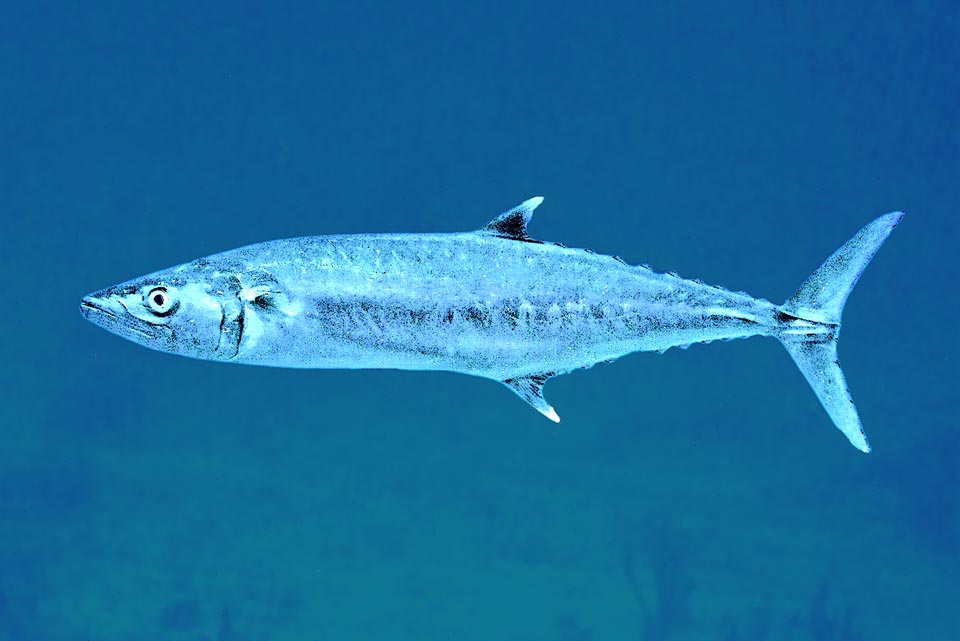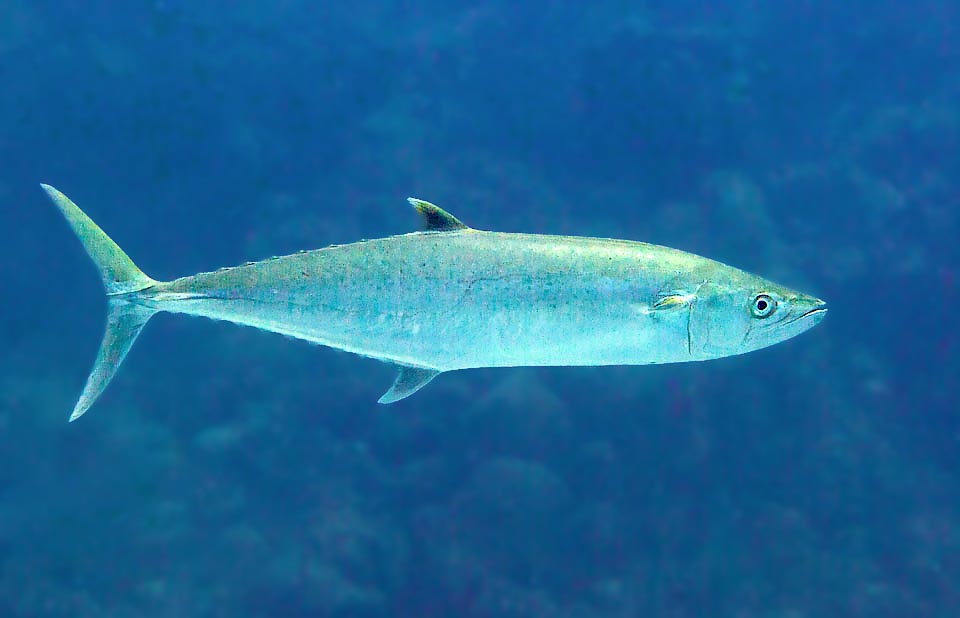Family : Scombridae

Text © Giuseppe Mazza

English translation by Mario Beltramini

At first sight, elongated and shining as it is, with sharp teeth, it could lead to think to a barracuda, instead Scomberomorus cavalla is a feisty relative of mackerels © Allison & Carlos Estape
At first sight due to its glittering livery, the size and the sharp teeth, it evokes a barracuda, but, as suggests the name, the King mackerel, Scomberomorus cavalla (Cuvier, 1829), is a close relative of the Mackerel (Scomber scombrus).
Both belong to the class of the Actinopterygii, the ray-finned fishes, to the order of the Perciformes and to the family of the Scombridae, but whilst the Mackerel reaches a maximum of 60 cm of length and a weight of 3,4 kg, the record of the King mackerel is of 184 cm and 45 kg. However, much less than the Atlantic bluefin tuna (Thunnus thynnus), that remains the giant of the family with a record of 458 cm and 684 kg.
The genus Scomberomorus comes from the Latin “scomber”, mackerel, and “omorus”, with the same range, to remind that they are similar fishes, whilst the specific term cavalla is simply the name the Portuguese gave to this species.
Zoogeography
Scomberomorus cavalla has a vast distribution in the west Atlantic, from the coasts of Canada up to Brazil. Eastwards it reaches Saint Peter and Paul Archipelago and that of Trindade and Martim Vaz at more than 1000 km far away from the coasts of Espirito Santo.

It has a vast distribution in western Atlantic, from the coasts of Canada to Brazil, and even if the catch is usually smaller it can reach the 184 cm and 45 kg © Allison & Carlos Estape
Ecology-Habitat
The King mackerel is a pelagic-neritic oceanodromous fish, that is, it also travels long distances and migrates in the ocean without exceeding 200 m of depth. In fact it stops at 140 m and often goes swimming in relatively shallow waters, between 5 and 15 m.
Morphophysiology
Elongated and very compressed laterally, Scomberomorus cavalla has the snout shorter than the head. THe mouth is equipped with about thirty solid sharp triangular teeth similar to knives.
There are 2 dorsal fins. The first, almost always folded, counts together with the second, taller, a total of 12-18 spiny rays and 15-18 soft rays. Then follow on the back 7-10 pinnulae and as many after the anal fin formed by 15-20 unarmed rays. The pelvic ones have one spine and 5 soft rays; the pectoral ones 16-20 soft rays and the caudal is forked as befits fast swimmers. We also note towards the tail a big keel followed by two smaller ones.

It chiefly feeds on the fishes moving in schools, but also on small groupers, mollusks and crustaceans © Allison & Carlos Estape
The King mackerel has no swim bladder and the lateral line bends sharply downwards at the level of the second dorsal fin. The livery is silver with iridescent blue-green back showing indistinct spots and bars on the sides.
The juveniles have 5-6 irregular rows of bronze small stains.
Ethology-Reproductive Biology
Scomberomorus cavalla usually attacks the 10-15 cm fishes moving in schools, but also bigger preys such as Caranx ruber or Epinephelus striatus, shrimps and squids. Juveniles chiefly feed on anchovies and small crustaceans.
In turn it is preyed upon by dolphins, tuna and sharks, non to mention man.
As well as ending up in the nets is in fact a coveted trophy of the sport fishermen who transform it often into steaks regardless a possible ciguatera poisoning, when it has been eating for years of fishes who store in their diet the toxin produced by the dinoflagellate Gambierdiscus toxicus.

It’s preyed upon by dolphins, tuna and sharks, but also by man, coveted trophy of sport fishermen © Allison & Carlos Estape
Little is known about its reproduction. The males are sexually mature when they are 3 years old. The female ovaries go through five stages and even if they may spawn before, they reach the top of the productivity about 4 years when they entrust to the currents even 12.000.000 of eggs.
Moreover, the juveniles have a lifespan of 26 years.
The resilience of the species is mediocre with a possible doubling of the populations in 1,4-4,4 years, and the fishing vulnerability, moderately high, marks 48 on a scale of 100.
In any case, Scomberomorus cavalla appears in the IUCN Red List dated September 2010 of the endangered species as “Least Concern”.
Synonyms
Cybium cavalla Cuvier, 1829; Cybium caballa Cuvier, 1832; Scomberomorus caballa (Cuvier, 1832); Cybium acervum Cuvier, 1832; Cybium clupeoideum Cuvier, 1832; Cybium immaculatum Cuvier, 1832.
